a three nucleotide sequence that encodes an amino acid
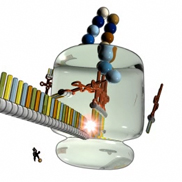
The ribosome assembles the polypeptide chain
To manufacture protein molecules, a cellphone must first transfer information from DNA to template RNA through the swear out of arrangement. Then, a process called translation uses this mRNA every bit a template for protein assembly. As a matter of fact, this flow of information from DNA to RNA and finally to protein is considered the central dogma of genetics, and it is the terminus a quo for apprehension the go of the genetic data in DNA.
But just how does translation work on? In other words, how does the cellphone register and interpret the information that is stored in DNA and carried in mRNA? The answer to this question lies in a series of complex mechanisms, most of which are associated with the cellular structure notable as the ribosome. In edict to understand these mechanisms, yet, it's first necessary to take a nigher take the concept known as the genetic code.
What is the genetic code?
At its heart, the genetic cypher is the set of "rules" that a cell uses to interpret the nucleotide sequence inside a corpuscle of mRNA. This sequence is broken into a series of three-nucleotide units notable arsenic codons (Number 1). The three-varsity letter nature of codons agency that the four nucleotides launch in messenger RNA — A, U, G, and C — dismiss produce a whole of 64 different combinations. Of these 64 codons, 61 act amino acids, and the remaining tercet represent diaphragm signals, which trigger the end of protein synthetic thinking. Because there are only 20 different amino acids but 64 possible codons, most alkane series acids are indicated by more than one and only codon. (Note, however, that each codon represents only one aminoalkanoic acid or stop codon.) This phenomenon is proverbial As redundance OR corruption, and it is important to the genetic code because it minimizes the unfavorable effects that wrongly placed nucleotides can have on protein synthesis. Sooner or later another factor in that helps mitigate these potentially damaging effects is the fact that there is no lap in the genetic code. This way that the three nucleotides within a particular codon are a component of that codon only — thus, they are not enclosed in either of the adjacent codons.
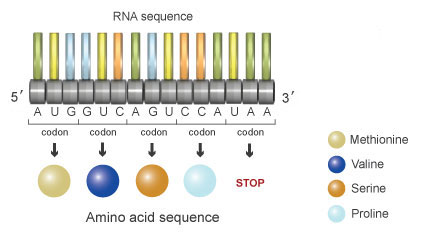
Figure 1: In messenger RNA, three-nucleotide units called codons dictate a specific amino Zen. For exemplar, AUG codes for the aminoalkanoic acid methionine (beige).
The idea of codons was first projected aside Francis Crick and his colleagues in 1961. During that equal twelvemonth, John Marshall Nirenberg and Heinrich Matthaei began deciphering the genetic code, and they discovered that the codon UUU specifically represented the amino acid phenylalanine. Following this discovery, Nirenberg, Philip Leder, and Har Gobind Khorana eventually identified the rest of the genetic code and amply represented which codons corresponded to which amino acids.
Reading the genetic encipher
Redundance in the genetical code means that most paraffin acids are mere by more than one mRNA codon. For exemplar, the amino acid phenylalanine (Phe) is specific by the codons UUU and UUC, and the aminoalkanoic acid leucine (Leu) is specified by the codons CUU, CUC, CUA, and CUG. Methionine is specified by the codon AUG, which is too famous as the start codon. Consequently, methionine is the commencement amino Elvis to dock in the ribosome during the synthesis of proteins. Tryptophan is unique because it is the only amino acid nominative by a single codon. The remaining 19 amino acids are specified by betwixt two and six codons each. The codons UAA, UAG, and UGA are the stop codons that signal the end point of interlingual rendition. Physique 2 shows the 64 codon combinations and the aminic acids OR hold bac signals they specify.
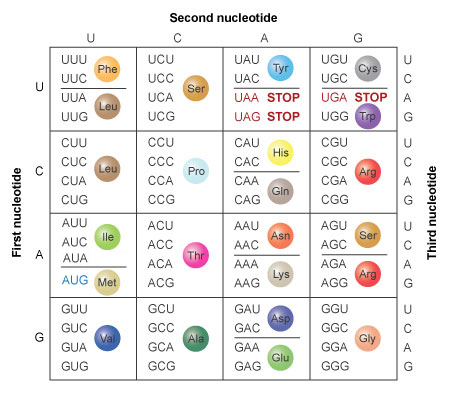
Figure 2: The amino acids specified past each mRNA codon. Multiple codons rear code for the same amino acid.
What role do ribosomes play in translation?
A previously mentioned, ribosomes are the technical cancellated structures in which translation takes place. This way that ribosomes are the sites at which the genetic code is actually read by a cell. Ribosomes are themselves composed of a complex of proteins and specialised RNA molecules called ribosomal RNA (rRNA).
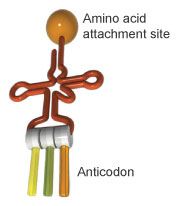
Material body 3: A tRNA molecule combines an anticodon chronological succession with an alkane series sour.
During translation, ribosomes move along an mRNA strand, and with the help of proteins called initiation factors, elongation factors, and departure factors, they assemble the sequence of amino acids indicated by the mRNA, thereby forming a protein. Systematic for this assembly to occur, even so, the ribosomes must be surrounded past small but critical molecules called transfer RNA (acceptor RNA). Each tRNA corpuscle consists of cardinal distinct ends, one of which binds to a peculiar amino acid, and the other which binds to a taxonomic group codon in the mRNA chronological succession because it carries a series of nucleotides called an anticodon (Figure 3). In this way, tRNA functions as an adaptor betwixt the genetic substance and the protein product. (The exact role of tRNA is explained in much depth in the following sections.)
What are the steps in translation?
Like transcription, translation can also be impoverished into three definite phases: initiation, elongation, and resultant. All three phases of translation involve the ribosome, which directs the interlingual rendition process. Sixfold ribosomes can interpret a single mRNA molecule at the same time, but all of these ribosomes must begin at the first codon and go out along the mRNA strand one codon at a time until reaching the stop codon. This group of ribosomes, a.k.a. a polysome, allows for the cooccurring production of multiple strings of amino acids, known as polypeptides, from one mRNA. When released, these polypeptides may be complete OR, American Samoa is often the case, they may require further processing to become mature proteins.
Creation
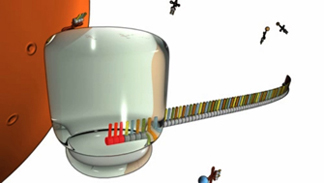
Figure 4: During installation, the ribosome (grey globe) docks onto the mRNA at a spatial relation dear the start codon (ruby-red).
At the start of the initiation phase of translation, the ribosome attaches to the informational RNA chain and finds the kickoff of the biology message, called the go codon (Figure 4). This codon is almost always AUG, which corresponds to the amino acid methionine. Next, the particular tRNA molecule that carries methionine recognizes this codon and binds to that (Figure 5). At this target, the initiation phase of translation is complete.
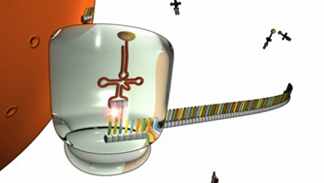
Figure 5: To all-out the initiation form, the tRNA molecule that carries methionine recognizes the start codon and binds to it.
Elongation
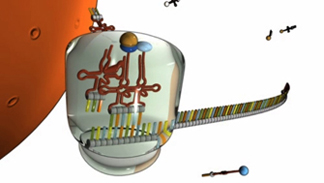
Shape 6: Inside the ribosome, multiple tRNA molecules bind to the mRNA strand in the appropriate succession.
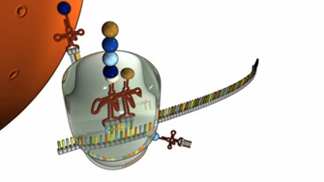
Figure 7: Each ordered tRNA leaves behind an paraffin acidulent that golf links in sequence. The resulting chain of amino acids emerges from the top of the ribosome.
The succeeding step in translation, called elongation, begins when the ribosome shifts to the next codon on the mRNA. At this show, the corresponding tRNA binds to this codon and, for a short time, thither are cardinal tRNA molecules on the mRNA strand. The amino acids carried by these soluble RN molecules are then bound unneurotic. After this binding has occurred, the ribosome shifts again, and the first transfer RNA, which is no longer contiguous to its corresponding amino acid, is released (Visualize 6). Now, the third codon in the mRNA strand is ready and waiting to tie with the appropriate tRNA (Figure 7). Again, the acceptor RNA binds to the mRNA strand, the third amino acid is added to the serial, the ribosome shifts, and the second soluble RN (which no longer carries an amino acid) is released. This process is repeated along the entire length of the mRNA, thereby elongating the polypeptide chain that is emerging from the crown of the ribosome (Figure 8).
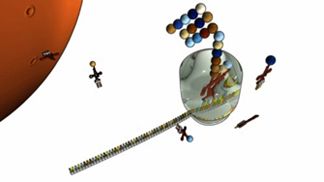
Figure 8: The polypeptide elongates as the process of tRNA moorage and aminoalkanoic acid bond is repeated.
Termination
Eventually, after extension has proceeded for some time, the ribosome comes to a stop codon, which signals the end of the genetic message. As a result, the ribosome detaches from the mRNA and releases the aminoalkanoic acid chemical chain. This marks the final phase of translation, which is called end point (Figure 9).
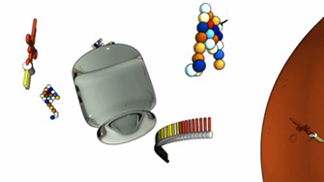
Figure 9: The translation process terminates after a stop codon signals the ribosome to fall off the RNA.
What happens after interlingual rendition?
For many proteins, translation is lonesome the first step in their life sentence cycle. Centrist to extensive post-translational alteration is sometimes required before a protein is complete. For example, some polypeptide irons necessitate the addition of unusual molecules before they are considered "processed" proteins. Still other polypeptides must have unique sections far through a process called proteolysis. Often, this involves the excision of the first aminoalkanoic acid in the mountain range (ordinarily methionine, as this is the particular amino acid indicated by the start codon).
Once a protein is complete, it has a job to execute. Some proteins are enzymes that catalyze organic chemistry reactions. Other proteins play roles in DNA replication and recording. Yet other proteins provide structural support for the cell, create channels through the cell membrane, or carry out one of many other important cellular support functions.
Watch this video for a summary of version in eukaryotes
a three nucleotide sequence that encodes an amino acid
Source: https://www.nature.com/scitable/topicpage/the-information-in-dna-determines-cellular-function-6523228/
Posting Komentar untuk "a three nucleotide sequence that encodes an amino acid"